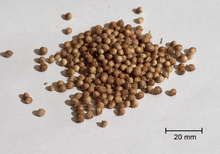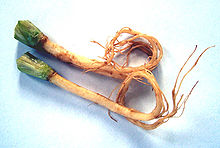 |
|
|
|
|
| Cuisines | Herbal | Spice | Curry | Yeast | Recipe | ||||||
|
Cilantro Coriander (Coriandrum sativum), also known as cilantro, Chinese parsley or dhania, is an annual herb in the family Apiaceae. Coriander is native to regions spanning from southern Europe and North Africa to southwestern Asia. It is a soft, hairless plant growing to 50 cm (20 in) tall. The leaves are variable in shape, broadly lobed at the base of the plant, and slender and feathery higher on the flowering stems. The flowers are borne in small umbels, white or very pale pink, asymmetrical, with the petals pointing away from the centre of the umbel longer (5–6 mm) than those pointing towards it (only 1–3 mm long). The fruit is a globular, dry schizocarp 3–5 mm (0.12–0.20 in) in diameter. UsesAll parts of the plant are edible, but the fresh leaves and the dried seeds are the parts most commonly used in cooking. Coriander is common in South Asian, Middle Eastern, Central Asian, Mediterranean, Indian, Tex-Mex, Latin American, Portuguese, Chinese, African, and Scandinavian cuisine. LeavesThe leaves are variously referred to as coriander leaves, fresh coriander, Chinese parsley, or cilantro (particularly in North America). Fresh coriander leaves, also known as Chinese parsley or cilantro It should not be confused with culantro (Eryngium foetidum L.) which is a close relative to coriander (Coriandrum sativum L.) but has a distinctly different appearance, a much more potent volatile leaf oil and a stronger smell. The leaves have a different taste from the seeds, with citrus overtones. Many experience an unpleasant "soapy" taste or a rank smell and avoid the leaves. The flavours have also been compared to those of the stink bug, and similar chemical groups are involved (aldehydes). There appears to be a genetic component to the detection of "soapy" versus "herby" tastes. The fresh leaves are an ingredient in many South Asian foods (such as chutneys and salads), in Chinese dishes, in Mexican cooking, particularly in salsa and guacamole and as a garnish, and in salads in Russia and other CIS countries. Chopped coriander leaves are a garnish on Indian dishes such as dal. As heat diminishes their flavour, coriander leaves are often used raw or added to the dish immediately before serving. In Indian and Central Asian recipes, coriander leaves are used in large amounts and cooked until the flavour diminishes. The leaves spoil quickly when removed from the plant, and lose their aroma when dried or frozen. Fruit
The dry fruits are known as coriander or coriandi seeds. In India they are called dhania. The word "coriander" in food preparation may refer solely to these seeds (as a spice), rather than to the plant. The seeds have a lemony citrus flavour when crushed, due to terpenes linalool and pinene. It is described as warm, nutty, spicy, and orange-flavoured. The variety C. s. vulgare has a fruit diameter of 3–5 mm (0.12–0.20 in), while var. microcarpum fruits have a diameter of 1.5–3 mm (0.059–0.12 in). Large-fruited types are grown mainly by tropical and subtropical countries, e.g. Morocco, India and Australia, and contain a low volatile oil content (0.1-0.4%). They are used extensively for grinding and blending purposes in the spice trade. Types with smaller fruit are produced in temperate regions and usually have a volatile oil content of around 0.4-1.8%, so are highly valued as a raw material for the preparation of essential oil. It is commonly found both as whole dried seeds and in ground form. Seeds can be roasted or heated on a dry pan briefly before grinding to enhance and alter the aroma. Ground coriander seed loses flavour quickly in storage and is best ground fresh. Coriander seed is a spice in garam masala and Indian curries, which often employ the ground fruits in generous amounts together with cumin. It acts as a thickener. Roasted coriander seeds, called dhana dal, are eaten as a snack. It is the main ingredient of the two south Indian dishes: sambhar and rasam. Coriander seeds are boiled with water and drunk as indigenous medicine for colds. Outside of Asia, coriander seed is used for pickling vegetables, and making sausages in Germany and South Africa (see boerewors). In Russia and Central Europe, coriander seed is an occasional ingredient in rye bread as an alternative to caraway. Coriander seeds are used in European cuisine today, though they were more important in former centuries. Coriander seeds are used in brewing certain styles of beer, particularly some Belgian wheat beers. The coriander seeds are used with orange peel to add a citrus character. RootCoriander roots have a deeper, more intense flavour than the leaves. They are used in a variety of Asian cuisines. They are commonly used in Thai dishes, including soups and curry pastes. Health effects and medicinal uses
Coriander, like many spices, contains antioxidants, which can delay or prevent the spoilage of food seasoned with this spice. A study found both the leaves and seed to contain antioxidants, but the leaves were found to have a stronger effect. Chemicals derived from coriander leaves were found to have antibacterial activity against Salmonella choleraesuis, and this activity was found to be caused in part by these chemicals acting as nonionic surfactants. Coriander has been used as a folk medicine for the relief of anxiety and insomnia in Iran. Experiments in mice support its use as an anxiolytic. Coriander seeds are used in traditional Indian medicine as a diuretic by boiling equal amounts of coriander seeds and cumin seeds, then cooling and consuming the resulting liquid. In holistic and traditional medicine, it is used as a carminative and as a digestive aid. Coriander has been documented as a traditional treatment for diabetes. A study on mice found coriander extract had both insulin-releasing and insulin-like activity. Coriander seeds were found in a study on rats to have a significant hypolipidaemic effect, resulting in lowering of levels of total cholesterol and triglycerides, and increasing levels of high-density lipoprotein. This effect appeared to be caused by increasing synthesis of bile by the liver and increasing the breakdown of cholesterol into other compounds. Coriander can produce an allergic reaction in some people. |











